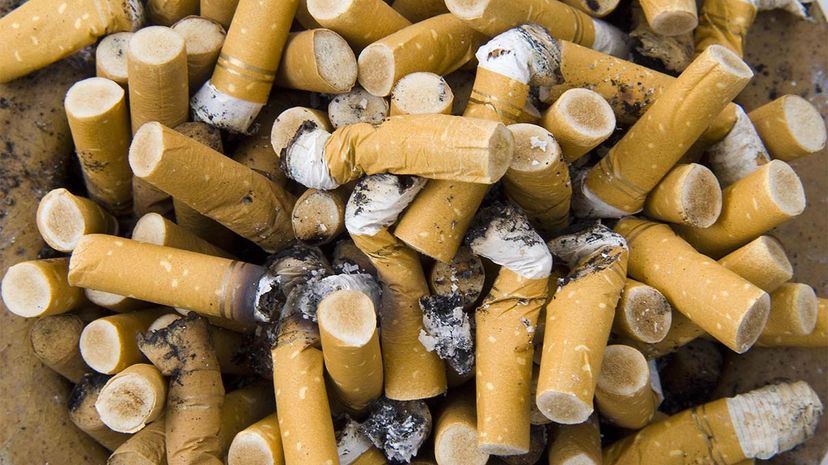 “The FDA is proposing cutting nicotine to non-addictive levels to help people quit and to reduce smoking deaths. Universal Images Group/Getty Images
“The FDA is proposing cutting nicotine to non-addictive levels to help people quit and to reduce smoking deaths. Universal Images Group/Getty Images
Last summer, in a dramatic policy shift, the U.S. Food and Drug Administration (FDA) announced that it wanted to look seriously at a new strategy for getting Americans to quit smoking. Instead of relying on warning labels and high taxes to drive away smokers, the agency would look at reducing or eliminating cigarettes’ ability to get smokers hooked, by reducing the amount of nicotine in them to minimally or sub-addictive levels.
Now, the agency is moving ahead with that approach. It recently issued an advance notice of proposed rulemaking, which invited interested parties to submit their comments and ideas on how nicotine might actually be reduced — what technological methods should be used, for example, and whether nicotine should be cut all at once or gradually phased out. It’s the first step toward what could be the end of smoking in the U.S. But one expert in tobacco regulation cautions that the process is likely to be a long and arduous one, and that even in a best-case scenario, a final rule that reduces nicotine might not be in place for another five to eight years.
The FDA’s plan to curb nicotine has gained momentum in part from a study that the agency funded, which was published in the March 15 issue of the New England Journal of Medicine. In it, researchers ran thousands of computer simulations on what might happen after enacting regulation to lower cigarettes’ nicotine content by 2020. In the median scenario produced by the model, cutting nicotine to sub-addictive levels would substantially reduce the percentage of the population who smoke, from the current 15 percent to less than 2 percent by 2100. Over that period, it would prevent 8.5 million deaths from smoking. (Here are the charts with those projections.)
At a March 15 media briefing, FDA Commissioner Scott Gottlieb, M.D., said that the proposed rule would enable the FDA "to pursue our vision of a world where combustible cigarettes would no longer create or sustain addiction. This would make it harder for future generations of vulnerable teens to become addicted in the first place, and it would allow more currently addicted smokers to quit or completely switch to potentially less harmful products."
Also speaking at the briefing was Mitch Zeller, director of the FDA’s Center for Tobacco Products. He emphasized that cutting nicotine was important to reducing the harm to public health caused by smoking, which he said kills half of all long-term users prematurely.
Cigarettes Are Addictive by Design
Almost 90 percent of adult smokers started smoking by the age of 18 and, we’ve known for decades that cigarettes are highly engineered and designed to get and keep users addicted," Zeller said. "More than half of adult cigarette smokers make a serious quit attempt each year, but most do not succeed due the highly addictive nature of cigarettes."
But the timetable and specifics of the nicotine reduction in cigarettes remain unclear. "It’s a really big deal, but the devil is in the details," explains Desmond Jenson, senior staff attorney for the Public Health Law Center at Mitchell Hamline School of Law in St. Paul, Minnesota. The center is a partner in the Tobacco Control Legal Consortium, which works with states and local communities on tobacco issues. "If the FDA moves forward with a standard that removed nicotine from any tobacco product, the best version of that would completely change the trajectory of the tobacco epidemic in the U.S."
Jenson says that for nicotine reduction to be effective, it would have to target all combustible tobacco products, not just cigarettes. "If they don’t approach it comprehensively, you’ll still see plenty of people smoking," he explains. He pointed to what happened when the federal government imposed higher taxes on cigarettes, small cigars and roll-your-own tobacco in an effort to curb smoking back in 2009. A Government Accountability Office investigation subsequently found that sales of large cigars and pipe tobacco — which weren’t taxed as heavily — actually increased.
American Heart Association chief executive Nancy Brown also stresses the importance of a sweeping reduction in nicotine. "We encourage the agency not to stop here but move forward quickly with a proposed rule on nicotine levels – not just for cigarettes, but for every combustible tobacco product on the market," she says in an email.
How to Do It?
It’s also unclear at this point exactly how nicotine would be reduced in cigarettes — whether it would be through chemical extraction or by genetically modifying the plants to contain lower nicotine. (One plant biotechnology company holds patents on methods that could reduce nicotine levels by 95 to 97 percent, Reuters reported in 2017.) Jenson says the FDA could specify a method, or simply set a standard and allow tobacco companies to choose how they would achieve it.
But before the FDA writes its final rule, it has to go through the laborious process of evaluating and responding to comments from interested parties, which Jenson estimates might amount to as many as 100,000 comments — some of them hundreds of pages long — before the process is completed.
"I wouldn’t expect a final rule for at least 5 to 8 years," Jenson says.
Now That’s Interesting
Nicotine from cigarette smoke is absorbed so rapidly by the human body that levels of nicotine peak within 10 seconds of inhalation, according to the National Institute on Drug Abuse.


